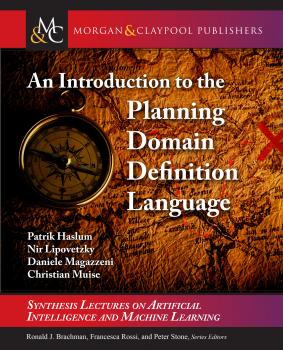Synthesis Lectures on Artificial Intelligence and Machine Learning
Скачать книги из серии Synthesis Lectures on Artificial Intelligence and Machine LearningMarkov Logic
Most subfields of computer science have an interface layer via which applications communicate with the infrastructure, and this is key to their success (e.g., the Internet in networking, the relational model in databases, etc.). So far this interface layer has been missing in AI. First-order logic and probabilistic graphical models each have some of the necessary features, but a viable interface layer requires combining both. Markov logic is a powerful new language that accomplishes this by attaching weights to first-order formulas and treating them as templates for features of Markov random fields. Most statistical models in wide use are special cases of Markov logic, and first-order logic is its infinite-weight limit. Inference algorithms for Markov logic combine ideas from satisfiability, Markov chain Monte Carlo, belief propagation, and resolution. Learning algorithms make use of conditional likelihood, convex optimization, and inductive logic programming. Markov logic has been successfully applied to problems in information extraction and integration, natural language processing, robot mapping, social networks, computational biology, and others, and is the basis of the open-source Alchemy system.
Essentials of Game Theory
Game theory is the mathematical study of interaction among independent, self-interested agents. The audience for game theory has grown dramatically in recent years, and now spans disciplines as diverse as political science, biology, psychology, economics, linguistics, sociology, and computer science, among others. What has been missing is a relatively short introduction to the field covering the common basis that anyone with a professional interest in game theory is likely to require. Such a text would minimize notation, ruthlessly focus on essentials, and yet not sacrifice rigor. This Synthesis Lecture aims to fill this gap by providing a concise and accessible introduction to the field. It covers the main classes of games, their representations, and the main concepts used to analyze them.
Federated Learning
How is it possible to allow multiple data owners to collaboratively train and use a shared prediction model while keeping all the local training data private? Traditional machine learning approaches need to combine all data at one location, typically a data center, which may very well violate the laws on user privacy and data confidentiality. Today, many parts of the world demand that technology companies treat user data carefully according to user-privacy laws. The European Union's General Data Protection Regulation (GDPR) is a prime example. In this book, we describe how federated machine learning addresses this problem with novel solutions combining distributed machine learning, cryptography and security, and incentive mechanism design based on economic principles and game theory. We explain different types of privacy-preserving machine learning solutions and their technological backgrounds, and highlight some representative practical use cases. We show how federated learning can become the foundation of next-generation machine learning that caters to technological and societal needs for responsible AI development and application.
Multi-Objective Decision Making
Many real-world decision problems have multiple objectives. For example, when choosing a medical treatment plan, we want to maximize the efficacy of the treatment, but also minimize the side effects. These objectives typically conflict, e.g., we can often increase the efficacy of the treatment, but at the cost of more severe side effects. In this book, we outline how to deal with multiple objectives in decision-theoretic planning and reinforcement learning algorithms. To illustrate this, we employ the popular problem classes of multi-objective Markov decision processes (MOMDPs) and multi-objective coordination graphs (MO-CoGs). First, we discuss different use cases for multi-objective decision making, and why they often necessitate explicitly multi-objective algorithms. We advocate a utility-based approach to multi-objective decision making, i.e., that what constitutes an optimal solution to a multi-objective decision problem should be derived from the available information about user utility. We show how different assumptions about user utility and what types of policies are allowed lead to different solution concepts, which we outline in a taxonomy of multi-objective decision problems. Second, we show how to create new methods for multi-objective decision making using existing single-objective methods as a basis. Focusing on planning, we describe two ways to creating multi-objective algorithms: in the inner loop approach, the inner workings of a single-objective method are adapted to work with multi-objective solution concepts; in the outer loop approach, a wrapper is created around a single-objective method that solves the multi-objective problem as a series of single-objective problems. After discussing the creation of such methods for the planning setting, we discuss how these approaches apply to the learning setting. Next, we discuss three promising application domains for multi-objective decision making algorithms: energy, health, and infrastructure and transportation. Finally, we conclude by outlining important open problems and promising future directions.
Statistical Relational Artificial Intelligence
An intelligent agent interacting with the real world will encounter individual people, courses, test results, drugs prescriptions, chairs, boxes, etc., and needs to reason about properties of these individuals and relations among them as well as cope with uncertainty.
Uncertainty has been studied in probability theory and graphical models, and relations have been studied in logic, in particular in the predicate calculus and its extensions. This book examines the foundations of combining logic and probability into what are called relational probabilistic models. It introduces representations, inference, and learning techniques for probability, logic, and their combinations.
The book focuses on two representations in detail: Markov logic networks, a relational extension of undirected graphical models and weighted first-order predicate calculus formula, and Problog, a probabilistic extension of logic programs that can also be viewed as a Turing-complete relational extension of Bayesian networks.









